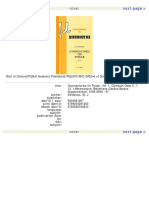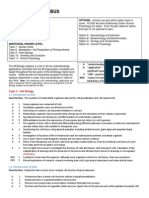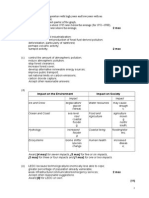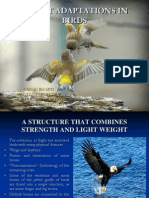NERVOUS SYSTEM (IB-DP BIOLOGY) - Multiple Choice Type Questions
NERVOUS SYSTEM (IB-DP BIOLOGY) - Multiple Choice Type Questions
Uploaded by
Vishnu SharmaCopyright:
Available Formats
NERVOUS SYSTEM (IB-DP BIOLOGY) - Multiple Choice Type Questions
NERVOUS SYSTEM (IB-DP BIOLOGY) - Multiple Choice Type Questions
Uploaded by
Vishnu SharmaOriginal Title
Copyright
Available Formats
Share this document
Did you find this document useful?
Is this content inappropriate?
Copyright:
Available Formats
NERVOUS SYSTEM (IB-DP BIOLOGY) - Multiple Choice Type Questions
NERVOUS SYSTEM (IB-DP BIOLOGY) - Multiple Choice Type Questions
Uploaded by
Vishnu SharmaCopyright:
Available Formats
NERVOUS SYSTEM (IB-DP BIOLOGY)- Multiple Choice Type Questions 1.
Which process decreases when the human body temperature decreases? A. B. C. D. 2. Blood flow to the internal organs Secretion of sweat Secretion of insulin Shivering
(Total 1 mark)
In thermoregulation, what would happen over a short period of time in each of these areas, if a person was placed in water at 15C ? Skeletal muscle Decreased shivering Increased shivering Increased shivering Increased shivering
(Total 1 mark)
Peripheral circulation Sweat glands Liver A Increased blood flow Increased secretion Decreased temperature B Decreased blood flow C Decreased blood flow D Decreased blood flow Decreased secretion Decreased temperature Increased secretion No change in temperature Decreased secretion No change in temperature
3.
The diagram shows how the body regulates glucose levels in the blood. G l u c o s e i n c r eX ar e s le e a s e d
l u
c o
s e
r m
a l
Y r e l e a s e d What is Y? A. B. C. D. Amylase Insulin Glucagon Glycogen
l u
c o
s e
e c r e a s e
(Total 1 mark)
4.
Which structure is responsible for passing messages directly to effector organs?
(Total 1 mark)
5.
The movement of which ion initiates an action potential? A. B. C. D. Calcium Magnesium Sodium Potassium
(Total 1 mark)
6.
Which best describes the role of the kidney in homeostasis? A. B. C. D. Storage of urine Producing urine at a constant rate Removing urea from the blood Maintaining the water content of the blood between narrow limits
(Total 1 mark)
7.
What is the role of active transport in the transmission of nerve impulses by neurones? A. B. C. D. Propagates an action potential by pumping sodium ions across the membrane out of the neurone. Propagates an action potential by pumping sodium ions across the membrane into the neurone. Initiates the action potential needed for the transmission of an impulse by pumping calcium ions out of the endoplasmic reticulum. Establishes the resting potential needed for the transmission of an impulse by pumping sodium and potassium ions across the membrane.
(Total 1 mark)
8.
Which cells secrete insulin? A. B. C.
-cells of the pancreas
Cells of the liver -cells of the pancreas
D.
Epithelial cells of the intestine
(1)
9.
Which of the following is closely associated with lowering of high body temperature? A. B. C. D. Constriction of blood vessels in the skin Vasodilation of blood vessels in the skin Increased shivering Decreased sweat production
(1)
10.
Arterioles in the skin contain muscle fibres which contract. What is the function of these fibres? A. B. C. D. To move capillaries further from the skin when the body is too cold To reduce blood flow to the skin when the body is too cold To move capillaries closer to the skin when the body is too warm To increase blood flow to the skin when the body is too warm
(Total 1 mark)
11.
What substance enters the presynaptic neuron during synaptic transmission and what substance leaves it? A. B. C. D. Substance entering presynaptic neuron Neurotransmitter Neurotransmitter Sodium ions (Na ) Calcium ions (Ca )
2+ +
Substance leaving presynaptic neuron 2+ Calcium ions (Ca ) + Sodium ions (Na ) Neurotransmitter Neurotransmitter
(Total 1 mark)
12.
Under what conditions is glucagon secretion increased? A. B. C. D. After fasting for a long period While resting After a meal rich in carbohydrates When the temperature falls
(Total 1 mark)
13.
Membrane proteins are critical components of nerve function. Which process in nerves does not require a membrane protein? A. B. C. Diffusion of neurotransmitter Active transport of sodium Propagation of an action potential
D. 14.
Binding of neurotransmitter
(Total 1 mark)
Which division describes the central nervous system? A. B. C. D. Peripheral and central Voluntary and involuntary nerves Brain and spinal cord Sensory and motor nerves
(Total 1 mark)
15.
How do endocrine glands function when they are involved in homeostasis? A. B. C. D. They release hormones directly into the blood system. They release hormones through ducts to where they are used. They release digestive enzymes from the pancreas. They cause positive feedback in the bodys structures.
(Total 1 mark)
16.
Which play a role in controlling body temperature? I. II. III. A. B. C. D. I and II only I and III only II and III only I, II and III
(Total 1 mark)
Blood Skin arterioles Body hair
17.
What substance is released into the blood by the pancreas when blood glucose levels are low? A. B. C. D. Glucose Glucagon Glycogen Insulin
(Total 1 mark)
18.
After depolorization what happens to restore the resting potential? A. B. C. D. Sodium channels open and sodium ions diffuse out of the neuron Potassium channels open and potassium ions diffuse into the neuron Potassium channels open and potassium ions diffuse out of the neuron Sodium channels open and sodium ions diffuse into the neuron
(Total 1 mark)
19.
Which ion is pumped into the axon of a neuron to help maintain the resting potential? A. Calcium (Ca )
2+
B. C. D. 20.
Hydrogen (H ) Potassium (K ) Sodium (Na )
(Total 1 mark)
+ +
What causes a resting potential to develop in a neuron? A. B. C. D. Diffusion of sodium and potassium ions Active transport of sodium and potassium ions Active transport of sodium and diffusion of chloride ions Active transport of potassium and diffusion of chloride ions
(Total 1 mark)
You might also like
- Test Bank For Guyton and Hall Textbook of Medical Physiology (Guyton Physiology) 14th Edition by John E. Hall, Michael E. HallDocument40 pagesTest Bank For Guyton and Hall Textbook of Medical Physiology (Guyton Physiology) 14th Edition by John E. Hall, Michael E. Halltestssolutions7No ratings yet
- Gone With The Rainy SeasonDocument7 pagesGone With The Rainy SeasonAnna Zhou0% (1)
- Typography in Hope Mirrlees' ParisDocument9 pagesTypography in Hope Mirrlees' ParisOindrilaBanerjeeNo ratings yet
- Ess Revision NotesDocument36 pagesEss Revision NotesVishnu Sharma100% (8)
- Wall ChartDocument1 pageWall ChartLila Joy100% (3)
- Chapter 3 Water and Life: Campbell's Biology, 9e (Reece Et Al.)Document23 pagesChapter 3 Water and Life: Campbell's Biology, 9e (Reece Et Al.)yousef farag100% (1)
- UtopiaDocument10 pagesUtopiaIqtedar AlamNo ratings yet
- The Romans in Films Roland BarthesDocument2 pagesThe Romans in Films Roland BarthesAkbar Hassan100% (1)
- Life and Death in Joyces DublinersDocument91 pagesLife and Death in Joyces Dublinersadrijen brodskiNo ratings yet
- Chapter 1 - Plot Summary: Albert Camus L'etrangerDocument17 pagesChapter 1 - Plot Summary: Albert Camus L'etrangerGanaNwanaNo ratings yet
- Bakhtin's Chronotope On The RoadDocument17 pagesBakhtin's Chronotope On The RoadLeandro OliveiraNo ratings yet
- Circulation and Gas Exchange: For Campbell Biology, Ninth EditionDocument116 pagesCirculation and Gas Exchange: For Campbell Biology, Ninth EditionMahnoor AnjumNo ratings yet
- IB World Literature Paper 1Document6 pagesIB World Literature Paper 1uche755No ratings yet
- The Idea of The Modern: Erika Mihálycsa, PHDDocument16 pagesThe Idea of The Modern: Erika Mihálycsa, PHDAlexis GogoașăNo ratings yet
- 14 Verdenius - Commentaries On Pindar - 1 - Olympian Odes 3, 7, 12, 14 - 1987 - ET PDFDocument142 pages14 Verdenius - Commentaries On Pindar - 1 - Olympian Odes 3, 7, 12, 14 - 1987 - ET PDFLaura GallardoNo ratings yet
- From Mother and Daughter: Poems, Dialogues, and Letters of Les Dames des RochesFrom EverandFrom Mother and Daughter: Poems, Dialogues, and Letters of Les Dames des RochesNo ratings yet
- The Reluctant FundamentalistDocument8 pagesThe Reluctant FundamentalistAmogh SahuNo ratings yet
- Aristophanes' Women at The ThesmophoriaDocument40 pagesAristophanes' Women at The ThesmophoriaLisa DornNo ratings yet
- He Ying's Assignment 2 of ABPL20033Document21 pagesHe Ying's Assignment 2 of ABPL20033Qi DaiNo ratings yet
- Froissart ChroniclesDocument3 pagesFroissart ChroniclesmedievalageNo ratings yet
- Charlotte Perkins Gilman On The Theory and Practice of FeminismDocument20 pagesCharlotte Perkins Gilman On The Theory and Practice of FeminismKohei SaitoNo ratings yet
- Duchamp CamfieldDocument47 pagesDuchamp Camfieldcristina nistor100% (2)
- Translating Humor in The TV Show BoJack Horseman (English To Spanish)Document15 pagesTranslating Humor in The TV Show BoJack Horseman (English To Spanish)Paulina MazurNo ratings yet
- Anatomy and Physiology Post Test 2Document3 pagesAnatomy and Physiology Post Test 2Golda Mir MacabitasNo ratings yet
- Bio Past PaperDocument36 pagesBio Past PaperYen Hyoung ChoNo ratings yet
- Ans MCQDocument30 pagesAns MCQSiavash HosseinjanzadehNo ratings yet
- O Level Biology Practice Questions And Answers HomeostasisFrom EverandO Level Biology Practice Questions And Answers HomeostasisRating: 5 out of 5 stars5/5 (1)
- LXL_Gr12LSci_11_Homeostasis_Live_5_August_2015Document10 pagesLXL_Gr12LSci_11_Homeostasis_Live_5_August_2015pinkiedimakatsoNo ratings yet
- General PhysioDocument30 pagesGeneral PhysiopayalpachiNo ratings yet
- ICSE Class 10 Biology Solution For Term 2 Exam 2021 22Document8 pagesICSE Class 10 Biology Solution For Term 2 Exam 2021 22VedantNo ratings yet
- Patho AssignmentDocument3 pagesPatho Assignmentjjsaints332No ratings yet
- 2015 Lecture 1 Tutorial Questions PDFDocument2 pages2015 Lecture 1 Tutorial Questions PDFFafa MusNo ratings yet
- Uj 36787+SOURCE1+SOURCE1.1Document10 pagesUj 36787+SOURCE1+SOURCE1.12803214No ratings yet
- CEM Practice Test - Biology - WITH NOTESDocument62 pagesCEM Practice Test - Biology - WITH NOTESJabeza RascalNo ratings yet
- 1 Questions - Endocrine, Urinary and Reproductive System TutoralsDocument31 pages1 Questions - Endocrine, Urinary and Reproductive System Tutoralslumshaline60No ratings yet
- 1st Test Bio (2) Sample2Document6 pages1st Test Bio (2) Sample2eman abdulghanyNo ratings yet
- 2020 Form 5 Biology Mock Exam: A Saliva Secretion Is An Involuntary Action Controlled by U (Medulla)Document22 pages2020 Form 5 Biology Mock Exam: A Saliva Secretion Is An Involuntary Action Controlled by U (Medulla)UniversityJCNo ratings yet
- Untitled Document-4Document4 pagesUntitled Document-4Puspita RoyNo ratings yet
- 8th Mid McqsDocument25 pages8th Mid McqsMuhammad Uzair GujjarNo ratings yet
- NLC Physio JULY 2023 McqsDocument12 pagesNLC Physio JULY 2023 Mcqsshrey100% (1)
- 11.Human body and organ system notes_Document8 pages11.Human body and organ system notes_jhasujata0891No ratings yet
- Marking Key For Grade 12 Biology TestDocument4 pagesMarking Key For Grade 12 Biology Testchipochewe308No ratings yet
- Quiz most important MCQDocument18 pagesQuiz most important MCQcrick0062006No ratings yet
- CCM 3123 Human Physiology IDocument11 pagesCCM 3123 Human Physiology Iy mugambiNo ratings yet
- MCQ Test On General Physiology and Nerve Muscle PhysiologyDocument9 pagesMCQ Test On General Physiology and Nerve Muscle PhysiologyAaisha SuhelNo ratings yet
- JR STAR NEET CBSE MT-12 ZOOLOGY ASSIGNMENTDocument8 pagesJR STAR NEET CBSE MT-12 ZOOLOGY ASSIGNMENTjmaureenfeliciaNo ratings yet
- Test Review Exam IIDocument4 pagesTest Review Exam IIburnermyth2No ratings yet
- Lesson 5 - Gas Exchange - Term 2 - G11 - Life ScienceDocument33 pagesLesson 5 - Gas Exchange - Term 2 - G11 - Life Sciencemkhwanazintokozo945No ratings yet
- physiology-mcqDocument10 pagesphysiology-mcqKkrish KatijaNo ratings yet
- Muscle Contraction and PhysiologyDocument10 pagesMuscle Contraction and PhysiologyKarthiga AnbazhaganNo ratings yet
- Hub Questions For The Lads x2Document21 pagesHub Questions For The Lads x2mosezifikileNo ratings yet
- BOARD EXAM QUESTION PAPER 2023 Biology (Chapter 1, 2)Document8 pagesBOARD EXAM QUESTION PAPER 2023 Biology (Chapter 1, 2)Anisha ThomasNo ratings yet
- VSP-UG-2 (General Physiology)Document23 pagesVSP-UG-2 (General Physiology)6qhx62pr42No ratings yet
- Excretion Question AnsweredDocument9 pagesExcretion Question AnsweredKeelah Benn50% (2)
- Q Bank Physio 30Document30 pagesQ Bank Physio 30haleemeltayebNo ratings yet
- A Rise in Blood TemperatureDocument1 pageA Rise in Blood TemperaturerohitNo ratings yet
- RiturajDocument4 pagesRiturajRevlo GhoshNo ratings yet
- 8 Hormones of Adrenal GlandDocument27 pages8 Hormones of Adrenal GlandRana AbdullahNo ratings yet
- Analysis of Past Question PapersDocument72 pagesAnalysis of Past Question PapersShamaNo ratings yet
- Pgi Physiology Exam: Your Email AddressDocument1 pagePgi Physiology Exam: Your Email AddressCharlie65129No ratings yet
- Environmental Systems & Societies Notes: Topic 1: Systems and ModelsDocument9 pagesEnvironmental Systems & Societies Notes: Topic 1: Systems and ModelsVishnu SharmaNo ratings yet
- Isotonic Point of A PotatoDocument12 pagesIsotonic Point of A PotatoVishnu Sharma100% (1)
- Unit 1-Heat CVD Lungs CF QuestionsDocument73 pagesUnit 1-Heat CVD Lungs CF Questionsareyouthere9267% (3)
- Enzymes: Seria L No. Questions 1) (w13 Qp11)Document8 pagesEnzymes: Seria L No. Questions 1) (w13 Qp11)Vishnu SharmaNo ratings yet
- Ib Biology Syllabus-NewDocument20 pagesIb Biology Syllabus-NewVishnu SharmaNo ratings yet
- Plant Nutrition: Serial No. QuestionsDocument4 pagesPlant Nutrition: Serial No. QuestionsVishnu SharmaNo ratings yet
- 0620 s05 Ms 1Document4 pages0620 s05 Ms 1Vishnu SharmaNo ratings yet
- Transport in Plants: Serial No. Questions 1) (w13 Qp11)Document7 pagesTransport in Plants: Serial No. Questions 1) (w13 Qp11)Vishnu SharmaNo ratings yet
- 2nd Chap QnbankDocument21 pages2nd Chap QnbankVishnu SharmaNo ratings yet
- MCQ Bank Igcse BiologyDocument24 pagesMCQ Bank Igcse BiologyVishnu Sharma100% (1)
- Test Bio2Document5 pagesTest Bio2Vishnu SharmaNo ratings yet
- Test Bio2Document5 pagesTest Bio2Vishnu SharmaNo ratings yet
- Paper Ess MsDocument6 pagesPaper Ess MsVishnu SharmaNo ratings yet
- MoleDocument9 pagesMoleVishnu SharmaNo ratings yet
- C5a Moles and Empirical Formulae: Relative Formula Mass Calculations - RevisionDocument14 pagesC5a Moles and Empirical Formulae: Relative Formula Mass Calculations - RevisionVishnu SharmaNo ratings yet
- Variation & Selection: Seria L No. Questions 1) (w12 Qp11)Document2 pagesVariation & Selection: Seria L No. Questions 1) (w12 Qp11)Vishnu SharmaNo ratings yet
- C5c Concentration and Quantitative AnalysisDocument5 pagesC5c Concentration and Quantitative AnalysisVishnu SharmaNo ratings yet
- Biotechnology and Genetic Engineering: Seri Al No. QuestionsDocument2 pagesBiotechnology and Genetic Engineering: Seri Al No. QuestionsVishnu SharmaNo ratings yet
- O o o O: Name: Grade: Date: Percent MassDocument1 pageO o o O: Name: Grade: Date: Percent MassVishnu SharmaNo ratings yet
- En 1Document8 pagesEn 1Vishnu SharmaNo ratings yet
- Raz lc43 Differentkindsofsharks CLR PDFDocument6 pagesRaz lc43 Differentkindsofsharks CLR PDFmistnehaNo ratings yet
- Turqiouse Parrot BioigraphyDocument6 pagesTurqiouse Parrot BioigraphyJeff GordonNo ratings yet
- Usmp Practica 12 - Histologia 2013 - Aparato UrinarioDocument48 pagesUsmp Practica 12 - Histologia 2013 - Aparato UrinarioCristian Anthony Goicochea CarhuatoctoNo ratings yet
- 1 1,6Document21 pages1 1,6DyahNo ratings yet
- History of Animal Taxonomy v2Document5 pagesHistory of Animal Taxonomy v2Cristie SumbillaNo ratings yet
- B SC MLS Batch 2011 - Unit Wise 01012016Document95 pagesB SC MLS Batch 2011 - Unit Wise 01012016harpreetNo ratings yet
- BDJ Article 108596Document12 pagesBDJ Article 108596japu.associationNo ratings yet
- Vocabulary - 4 Dinosaur DiscoveryDocument1 pageVocabulary - 4 Dinosaur DiscoveryAlifa Prima Budiarga, S.Pd.No ratings yet
- Oasis: Orange Audubon Society A Chapter of National Audubon Society and Audubon of FloridaDocument6 pagesOasis: Orange Audubon Society A Chapter of National Audubon Society and Audubon of FloridaOrange Audubon SocietyNo ratings yet
- Soal Sat-Pat 2024 B.ingg XDocument7 pagesSoal Sat-Pat 2024 B.ingg XAhmad ZuhdiNo ratings yet
- Hemirhamphodon Tengah Reproduction EnglishDocument6 pagesHemirhamphodon Tengah Reproduction EnglishZoran BunčićNo ratings yet
- Mendelian Genetics ProblemsDocument4 pagesMendelian Genetics ProblemsSuvigya VijayNo ratings yet
- Insect Reproductive SystemDocument3 pagesInsect Reproductive SystemLiezl Bornales ParreñoNo ratings yet
- Dynamic Metabolism of YeastDocument7 pagesDynamic Metabolism of Yeastonsalefor10centsNo ratings yet
- Endosymbiotic TheoryDocument4 pagesEndosymbiotic TheoryJoshi MaitreyeeNo ratings yet
- Find Your Minibeast PDFDocument3 pagesFind Your Minibeast PDFAnonymous xVTbc3T6No ratings yet
- Flight AdaptationsDocument25 pagesFlight AdaptationsUmesh Bharti100% (2)
- 1297943-Alchemy System 5EDocument4 pages1297943-Alchemy System 5Emaurizio plazziNo ratings yet
- Frigate Tuna: Auxis Thazard (Lacepède, 1800)Document7 pagesFrigate Tuna: Auxis Thazard (Lacepède, 1800)ifahNo ratings yet
- Organ System: Kingdom AnimaliaDocument18 pagesOrgan System: Kingdom AnimaliaTanishq AroraNo ratings yet
- Comparative Vertebrate Anatomy ReviewerDocument3 pagesComparative Vertebrate Anatomy ReviewerJohn Rudolf CatalanNo ratings yet
- Bio6 1Document6 pagesBio6 1HarmonyChuiNo ratings yet
- SPM BiologyDocument12 pagesSPM BiologyAidah Amir100% (1)
- ZV Rules (Small)Document12 pagesZV Rules (Small)val.qiyNo ratings yet
- DPP No. Standard 11Document1 pageDPP No. Standard 11Jyöt SîlvērNo ratings yet
- Bi0 310 Bacteria Lab ReportDocument11 pagesBi0 310 Bacteria Lab ReportChiletso PhiriNo ratings yet
- SR - KG October Month WorksheetDocument12 pagesSR - KG October Month Worksheetarunsuthar1122No ratings yet
- Endemism in South-East Europe: Regional Network For Biodiversity Information Management and Reporting (BIMR) " FundedDocument2 pagesEndemism in South-East Europe: Regional Network For Biodiversity Information Management and Reporting (BIMR) " Fundedzoka68No ratings yet
- FrankenfishDocument3 pagesFrankenfishapi-169639475No ratings yet













































































































